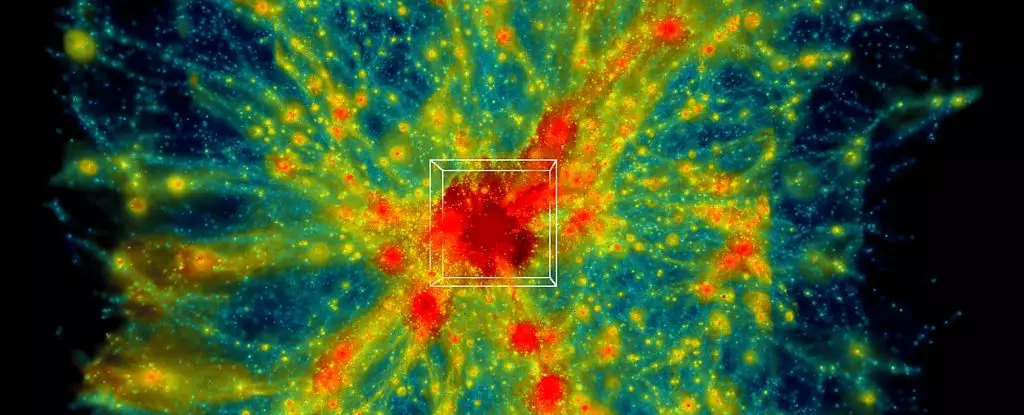In an impressive leap forward for astrophysics, a groundbreaking simulation at Oak Ridge National Laboratory has marked a monumental achievement: the largest astrophysical simulation of the universe to date. Dubbed ExaSky, this ambitious project utilized the extensive capabilities of the Frontier supercomputer, which employed 9,000 computing nodes to model a staggering volume of space exceeding 31 billion cubic megaparsecs. Set against the backdrop of ever-expanding cosmic mystery, ExaSky represents a critical stride toward elucidating the intricate evolution of the universe, particularly concerning the enigmatic nature of dark matter.
At the heart of ExaSky’s exploration lies the duality of the universe—dark matter, which interacts primarily through gravitational forces, and conventional atomic matter. According to physicist Salman Habib from Argonne National Laboratory, understanding the universe’s dynamics necessitates comprehensive simulations that address the interplay between these two elements. Habib aptly describes the simulations as a “kitchen sink,” illustrating the complexity of the astrophysical phenomena being modeled. The simulations encompass not just gravitational forces but also the relevant physics impacting hot gas, star formation, black holes, and galaxies, enabling scientists to create a multifaceted depiction of cosmic evolution.
Astrophysical phenomena operate over vast timescales that far exceed human comprehension. As we gaze across the boundless expanses of space, we are simultaneously viewing the past—a reality that challenges our understanding of cosmic evolution. Although our conventional understanding is limited to observable changes on shorter timescales, advanced simulations like ExaSky enhance our capabilities to visualize these astronomical processes. By adjusting variables, speeding up or rewinding time, and zooming in on specific features, scientists can examine the universe with an approach that simplifies its overwhelming complexity.
Despite the seeming simplicity of modeling the universe, the task is riddled with intricate challenges. The enormous scale of space combined with its inherent complexity necessitates sophisticated mathematics and cutting-edge computational power. Previous simulations faced limitations in incorporating variables crucial for accurate hydrodynamic modeling, often relying narrowly on gravity-based approximations. Habib emphasizes that simulating vast stretches of the universe as observed by prominent telescopes, such as the Rubin Observatory in Chile, has traditionally been unfeasible due to the extensive timescales involved—billions of years of universal expansion.
ExaSky’s development relied heavily on years of refinement in both the algorithms and the hardware powering the simulations. The Hardware/Hybrid Accelerated Cosmology Code played a pivotal role in enabling the simulation to run efficiently on the upgraded Frontier supercomputer. This level of enhancement allowed researchers to significantly expand their simulation capabilities, positioning ExaSky to model comprehensively the universe’s ominous expansion.
One of the most groundbreaking aspects of ExaSky is its capacity to represent a mere 0.001 percent of the cosmos yet still yield insights that could redefine astrophysics and cosmology. As astrophysicist Bronson Messer notes, the sheer volume derived from such sophisticated simulations allows for direct comparisons to contemporary observations, a leap toward bridging theoretical predictions with empirical data.
The implications of ExaSky extend beyond mere academic curiosity. By unraveling the complexity of cosmic evolution, this project addresses critical questions about dark matter—the unseen substance that permeates the universe yet eludes direct detection. In doing so, ExaSky can lay the groundwork for a deeper understanding of fundamental physics and the conditions that shape existence in the cosmos.
Ultimately, ExaSky represents not only a significant technical achievement but also a catalytic force for advancing our understanding of the universe. By pushing the boundaries of computational astrophysics and enabling a more nuanced simulation of cosmic phenomena, this project promises to ignite future research endeavors aimed at demystifying the vast universe we inhabit. As scientists probe deeper into the nature of dark matter and the universe’s intricate dynamics, the ExaSky simulation stands as a testament to human ingenuity and the relentless pursuit of knowledge that continues to define the field of astrophysics.


Leave a Reply